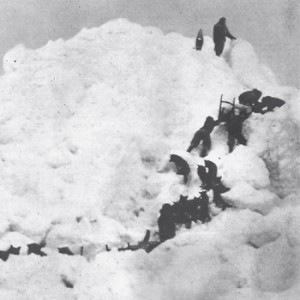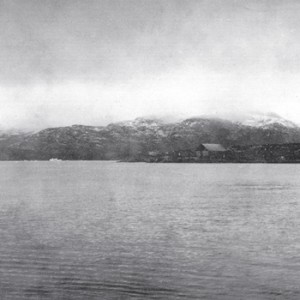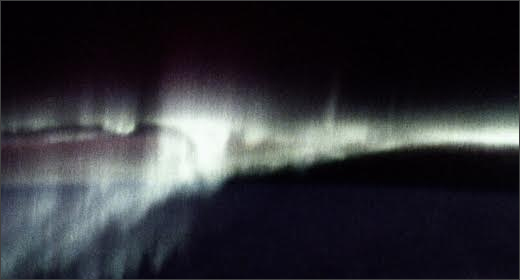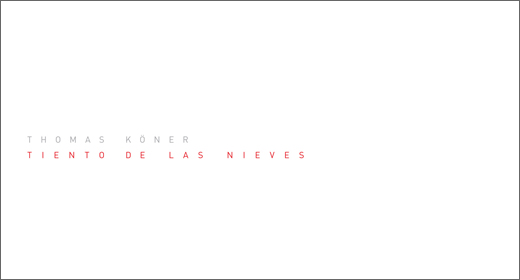For those unfamiliar with Thomas Köner‘s oeuvre (I certainly was until Type’s re-issue campaign this year), Nunatak, Teimo and Permafrost were his first three solo albums released through the now defunct Barooni label as limited edition compact discs way back in 1990, 1992 and 1993 respectively. Yes, that’s correct, these albums are up to twenty years old now.

[Listen | Purchase] Type have been producing some of the finest vinyl editions money can buy for quite some time; never fussy or over-thought, just beautifully printed and pressed on quality materials, sometimes with initial coloured vinyl runs, sometimes with a bonus CD of exclusive material thrown in for good measure. Earlier this year Type released newly remastered editions of these albums on vinyl for the first time, with carefully selected new artwork. All well and good, but what about those who don’t own a turntable and either can’t find copies of the original CD release or want to upgrade to these newly remastered editions? Type doesn’t disappoint there either, presenting this lavishly packaged (and for the time being not limited) three disc edition in a lovingly minimal, over-sized 14x14cm eight-panel foldout wallet, a fitting suit of armour for Köner’s heavyweight and hugely influential ambient recordings.

[Nunatak] Köner’s debut album is easily his most unusual, difficult and experimental, apparently constructed solely from electronically manipulated samples of gongs and it rapidly becomes clear that, source material aside, it has little in common with either Teimo or Permafrost. Aubrite – his fourth album – would have been a more stylistically consistent album to include in this set, but Type are being reverentially purist with this campaign by releasing them in their original chronological order. In many ways this makes the set far more interesting as it illustrates the clear evolution of Köner’s style from the early, isolationist horror-scapes of Nunatak through to the more widely heard and well known powdery drone music of his latter works.
On both Teimo and Permafrost Köner employs naming conventions that reference ice, ice formations and other associated phenomena, and while all of the tracks here are completely untitled – leaving the listener with no preconceived notions of context or setting – the word Nunatak is actually the name given to an exposed, rocky outcrop not covered in snow but nevertheless isolated within an ice field or a glacier.
Certainly Nunatak is not a comfortable place to be, and in places possesses the power to make you jump out of your seat in shock. On more than one occasion one is drawn in by its murky, seemingly bottomless drones and black ice only to be assaulted by a nerve-shredding shrieking or screeching (“Untitled 3,” “Untitled 5”) as gusts of frozen wind propel ice-shards out of the speakers. Elsewhere there’s a persistent onslaught of grunts, wheezes and snorts (“Untitled 1,” “Untitled 8”) that lurk in the shadows, further adding to the fraught atmosphere.
“Untitled 2” plays havoc with the ears should you happen to be listening on headphones as a dark, creaking drone like the rending of colossal ice-sheets materializes exclusively in the left channel, then switches in a different tone to the right, creating a sort of sonic vacuum that seems to suck air through your skull – physically unnerving. Both here and elsewhere, colossal, dark machinery thrums (“Untitled 4,” “Untitled 6”) alongside guttural groaning pitched somewhere between tortured whale-song and the twisting and wrenching of huge metal structures on the brink of collapse (“Untitled 7,” “Untitled 9”).
It’s an impressive feat given that all of these sounds are creating from a single source – various gongs in resonant chambers electronically manipulated to create bass wells, wails and atmospheric washes – and remains one of the most challenging of Köner’s releases to date.

Teimo is a complete sea-change for Köner, being the prettiest, most straightforward, musical and accessible of the three albums in this set. A masterclass in both ambient and drone music, it sees Köner in a transitional phase between the threatening environments and experimental, gong-sampling of Nunatak and the gargantuan, dwarfing atmospheres that would characterize his work from Permafrost onwards.
The drones and textures on Teimo are decidedly warmer, more harmonious and familiar but also immense and enveloping. The waveforms, pulses and majestic washes of sound and drawn out melodies of “Ilira” are like the push and pull of great tides deep underwater. The title track describes a submerged, multi-spired cathedral of crystal glinting in rippling shafts of light to the sound of the deep inhalations and exhalations of the planet itself, and the billow and swell of “Teimo (Schluss)”‘s alluring gossamer formations gently buoys the listener through warm water currents. I could never tire of these sounds even if the Earth’s atmosphere constantly emitted them, and yet with Köner’s typical, consummate economy they only grace our presence for around five minutes, gently evolving until the moment they reach their most affecting, natural beauty at which point they quickly slip away.
Conversely pieces like “Andenes” (the name of a coastal town in Northernmost Norway) and “Nieve Penitentes 3” again showcase Köner’s gong-sampling techniques. But whilst the latter does so in manner that more closely parallels Nuntak, “Andenes” drops them into an entirely different setting with much greater subtlety, not here to recreate the isolationist terror that runs through Nunatak but to conjure images of mini-submarine expeditions into dark, unexplored sub-aquatic ravines and caves, light shone into corners, the constant background hiss of oxygen supplies.
Though Teimo may not be as distinctive as either Nunatak or Permafrost, it is nevertheless a panoramic, immersive and pioneering marvel and a true benchmark of the genre.

Permafrost marks the pivotal evolution in Köner’s sound, establishing the template from which much of his subsequent work would derive, and though the stylistic jump from Permafrost to Teimo may at first appear less pronounced than that of Teimo to Nunatak the differences are deceptively large. It has staggering depth and potency, an exceptional rarity of the genre that captures vast, engulfing panoplies of sound within surprisingly compact forms. Once again this brevity works in the album’s favour to such an extent it’s a wonder that more artists haven’t favoured similarly shorter running times over super-extended drone works.
This can be more fully appreciated once you have experienced the album in several different listening contexts, at which point it becomes quite clear that the album sounds completely different in all of them. Oddly, given the vastness of scale on Permafrost the optimum listening experience seems to be via circumaural headphones (again good bass response is a must), which has the effect of dropping the listener right into the heart of the album’s six unique settings. Any other form of listening and you’re hearing both the album and everything else around you at the same time; timbres change, sounds that are prominent through headphones seem to vanish when heard through speakers, and this certainly seems to be in keeping with Köner’s exploration of the realms of sound colour, leaving almost all discernible rhythm and harmony behind in the process.
Much has been made of the references to frozen landscapes in Köner’s track titles and to the overall sound palette of Permafrost, and whilst Type’s selection of artwork is both appropriate and quite literal, there’s enough variation here for such a description to be completely irrelevant to a track like “Serac.” The title refers to a large, unstable block of ice found on glaciers but the overall texture marks a return to the rippling, aquatic pulsing and warm subterranean thrumming of giant engines so prominent on Teimo. Many of the landscapes created by Permafrost are quite the reverse of those found on Nunatak, not alien and fraught with tension but inviting – you want to experience the chill, the tousled, snow-drift soft-noise that accompany the great wells of bass, because the sheer spectacle of these locations is breathtaking.
It’s hard to single out particular moments of brilliance within Permafrost but certainly the ultimate expression of the album’s form (and indeed the longest) comes from the title track, which features the album’s deepest bass structures and most hypnotic and evolving atmospheres. To give listeners new to this album fair warning, it is near impossible to avoid falling asleep to “Permafrost” and if you have it on repeat, all too easy to end up listening to the album multiple times without even realising it. This aurally administered tranquillizer evokes trance-state inducing visions of the ripple of dry white powder across gently sloping snow caps that stretch into the far distance before disappearing into the horizon.
It seems criminal to lumber these albums with a label like drone music or the dreaded “dark ambient” for that matter, but it’s so hard to describe this “music” without sounding completely insane that all one can do is recommend that you listen to it for yourself. Beautifully charting the formative years of Köner’s work, this is one of the finest releases of 2010 and an essential entry in Type’s canon. As such it comes with the highest recommendation.
All releases above are out now on Type. [Listen | Purchase]



















![Luke’s Anger :: Ceiling Walker EP (Love Love) — [concise]](https://igloomag.com/wp/wp-content/uploads/2025/04/lukes-anger-ceiling-walker-vinyl_feat-75x75.jpg)

![Ndorfik & madebyitself :: Solos EP (People Can Listen) — [concise]](https://igloomag.com/wp/wp-content/uploads/2025/04/ndorfik-madebyitself-solos_feat-75x75.jpg)




